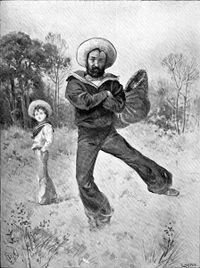Template:Featured Tune: Difference between revisions
No edit summary |
No edit summary |
||
| Line 3: | Line 3: | ||
<p><font face="Century Gothic" size="2"> | <p><font face="Century Gothic" size="2"> | ||
<div style="text-align: justify; direction: ltr; margin-left: 0pX; margin-right: 0px;"> | <div style="text-align: justify; direction: ltr; margin-left: 0pX; margin-right: 0px;"> | ||
[[File:Sailor sHornpipe.jpeg|200px| | [[File:Sailor sHornpipe.jpeg|200px|link=|left|]] | ||
Originally titled the "[[College Hornpipe (The)]]" this melody became known as the "Sailor's Hornpipe" through its association with the performance of the hornpipe dance, typically performed on the stage in nautical costume (see notes for "[[annotation:College Hornpipe (The)]]"). At the turn of the 18th century a sailor was a favorite character of the musical stage and the nautical theme became so associated with the dance that many hornpipes were generically labeled a 'sailor's hornpipe'. The dance itself features a distinctive 'side-cutting' step. The style retained its popularity throughout the century, and none-less than [[biography:J. Scott Skinner]], the famous Scottish violinist who was also a dancing master, taught the dance at Elgin and other places to his pupils. George Emerson, in his article on the Hornpipe ('''Folk Music Journal''', vol. 2, No. 1, 1970) finds an early reference: | Originally titled the "[[College Hornpipe (The)]]" this melody became known as the "Sailor's Hornpipe" through its association with the performance of the hornpipe dance, typically performed on the stage in nautical costume (see notes for "[[annotation:College Hornpipe (The)]]"). At the turn of the 18th century a sailor was a favorite character of the musical stage and the nautical theme became so associated with the dance that many hornpipes were generically labeled a 'sailor's hornpipe'. The dance itself features a distinctive 'side-cutting' step. The style retained its popularity throughout the century, and none-less than [[biography:J. Scott Skinner]], the famous Scottish violinist who was also a dancing master, taught the dance at Elgin and other places to his pupils. George Emerson, in his article on the Hornpipe ('''Folk Music Journal''', vol. 2, No. 1, 1970) finds an early reference: | ||
<blockquote> | <blockquote> | ||
Revision as of 18:04, 31 December 2018

Originally titled the "College Hornpipe (The)" this melody became known as the "Sailor's Hornpipe" through its association with the performance of the hornpipe dance, typically performed on the stage in nautical costume (see notes for "annotation:College Hornpipe (The)"). At the turn of the 18th century a sailor was a favorite character of the musical stage and the nautical theme became so associated with the dance that many hornpipes were generically labeled a 'sailor's hornpipe'. The dance itself features a distinctive 'side-cutting' step. The style retained its popularity throughout the century, and none-less than biography:J. Scott Skinner, the famous Scottish violinist who was also a dancing master, taught the dance at Elgin and other places to his pupils. George Emerson, in his article on the Hornpipe (Folk Music Journal, vol. 2, No. 1, 1970) finds an early reference:
”at Drury lane, May 1740, Yates ..is .. billed to perform a 'hornpipe in the character of Jacky Tar. There is no mention then or later of anyone performing 'the' or 'a' sailor's hornpipe. It is always a 'hornpipe in the character of a sailor'..”
Curiosly, it is surprising to find that a tune with such strong associations to nautical performance does not appear as "Sailor's Hornpipe" in printed collections until fairly recently. As the "College Hornpipe" the tune was in print in 1797 or 1798 by J. Dale of London, and although the melody predates Dale's publication, the English antiquarian Chappell's editor dates it no earlier than the second half of the 18th century. Emerson suggests the comic ballet The Wapping Landlady (1767) was the source of the Sailor Hornpipe that was famously danced by the American dancer Durang for some twenty years at the end of the 18th century. The ballet featured the trials of Jack Tar ashore, and was choreographed by Arnold Fisher (of “Fisher's Hornpipe” fame). See also note for “annotation:College Hornpipe (The)” for more.
"Sailor's Hornpipe" was imported to North America where it entered traditional repertoire and became fairly widely known, still with its nautical connotations--so strong was the association, in fact, that it was selected as the theme song of a popular mid-20th century animated cartoon character, Popeye the Sailorman. Bronner (1987) reports the earliest known printing in the United States was in a publication by B. Carr entitled Evening Entertainments in the year 1796 (under the "College Hornpipe" title). Although the name "Sailor's Hornpipe" has been something of a floating title in the United States, it is probably the 'College' tune under this title which was cited as having commonly been played for country dances in Orange County, New York, in the 1930's (Lettie Osborn, New York Folklore Quarterly). Similarly in American tradition, it was played at a fiddle contest in Verbena, Alabama, in 1921 (as noted in the Union Banner of October 27, 1921), and also in another 1920's contest in Georgia by one R.L. Stephens of Camp Hill, Alabama (according to the Columbus (Ga.) Register of December 10-12, 1926) {Cauthen, 1990}. The title also appears in a list of traditional Ozarks Mountains fiddle tunes compiled by musicologist/folklorist Vance Randolph, published in 1954. The late Kentucky fiddler George Lee Hawkins, renowned as a "hornpipe fiddler," played “Sailors” in the key of F.
SAILOR'S HORNPIPE full Score(s) and Annotations and Past Featured Tunes
X:1 T:Sailor’s Hornpipe [1] T:College Hornpipe M:C L:1/8 R:Hornpipe B:Harding’s All Round Collection, No. 177 (1905) Z:AK/Fiddler’s Companion K:Bbmaj B>A|B2 B,2 B,2 F>E|D>F B2 B>dc>B|c2C2C2 c>B|A>cf>=e f2 g>a| b>ag>f g>fe>d|e>dc>B B>AG>F|G>BA>c B>dc>e|d2B2B2||
